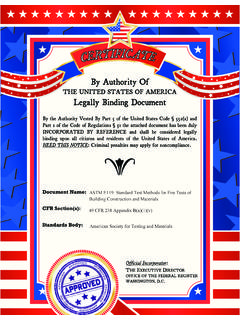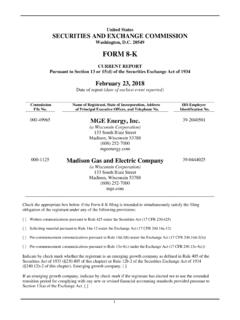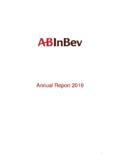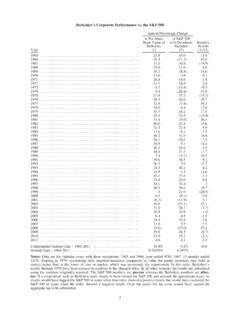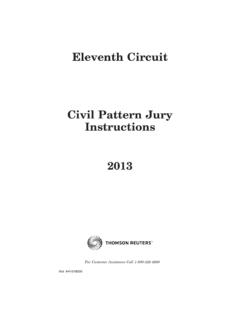Transcription of A study of storage tank accidents - technokontrol.com
1 A study of storage tank accidentsJames I. Changa,*, Cheng-Chung LinbaDepartment of safety, Health and Environmental Engineering, National Kaohsiung First University of Science and Technology, Kaohsiung, Taiwan, ROCbChang-Cheng storage Station, Chinese Petroleum Corporation, Kaohsiung, Taiwan, ROCR eceived 5 December 2004; received in revised form 19 May 2005; accepted 26 May 2005 AbstractThis paper reviews 242 accidents of storage tanks that occurred in industrial facilities over last 40 years. Fishbone Diagram is applied toanalyze the causes that lead to accidents . Corrective actions are also provided to help operating engineers handling similar situations in thefuture. The results show that 74% of accidents occurred in petroleum refineries, oil terminals or storage .
2 Fire and explosion account for 85%of the accidents . There were 80 accidents (33%) caused by lightning and 72 (30%) caused by human errors including poor operations andmaintenance. Other causes were equipment failure, sabotage, crack and rupture, leak and line rupture, static electricity, open flames etc. Mostof those accidents would have been avoided if good engineering have been Elsevier Ltd. All rights :Fishbone Diagram; Accident statistics, fire and explosion1. IntroductionStorage tanks in refineries and chemical plants containlarge volumes of flammable and hazardous chemicals. Asmall accident may lead to million-dollar property loss anda few days of production interruption. A large accidentresults in lawsuits, stock devaluation, or company bank-ruptcy.
3 In last 50 years, trade organizations and engineer-ing societies such as American petroleum institute (API),American institute of chemical engineers (AIChE),American society of mechanical engineers (ASME), andnational fire protection association (NFPA) have publishedstrict engineering guidelines and standards for theconstruction, material selection, design and safe manage-ment of storage tanks and their accessories (AIChE, 1988;1993; API, 1988; 1990; ASME, 2004; NFPA, 1992; UL,1986; 1987). Most companies follow those standards andguidelines in the design, construction and operation, buttank accidents still occur. Learning from the past history isdefinitely important for the future safe operation of purpose of this paper is to categorize the causes thatlead to 242 tank accidents occurred in last 40 years.
4 Thefishbone diagram (The cause and effect diagram) inventedby Dr Kaoru Ishikawa (Ishikawa and Lu, 1985) is used tosummarize the effects and the causes that create orcontribute to those effects. We hope that this work will bebeneficial to tank operators and Overall statisticsThe information of 242 tank accidents reviewed in thiswork was collected from published reports (March andMclennan, 1990; 1997; 2002; Persson and Lonnermark,2004), books (CPC, 1983; 2002; Pekalski, 1997; Lees,1996), CSB incident news (USCSB, 2000 2003)anddatabases (UQ, 2001; USCHSIB, 2004; ICHemE, 2002;PAJ, 2004; USNOAO, 1999). There were 114 occurred inNorth America, 72 in Asia and 38 in Europe (Table 1). USAhad 105 accidents reviewed because of the easy accessibilityto accident information.
5 As indicated inTable 2,accidentsoccurred more frequently at petroleum refineries with 116cases ( ). The second most frequently involved place wasterminals and pumping stations (64 cases, ). Only accidents occurred in petrochemical plants ( ), oilfields ( ), and other types of industrial facilities ( )such as power plants, gas plants, pipelines, fertilizer plants,Journal of Loss Prevention in the Process Industries 19 (2006) 51 $ - see front matterq2005 Elsevier Ltd. All rights *Corresponding author. Tel.:C886 916143783; fax:C886 7 ( Chang).etc. Crude oil, gasoline and oil products such as fuel oil, diesel,etc. were major contents (Table 3). The atmospheric externalfloating roof tank was the most frequent type and theatmospheric cone top tank was the second most frequenttype.
6 Both types were used extensively for the storage of crudeoil, gasoline, and diesel oil (Table 4).Fire was the most frequent type of loss with 145 casesand explosion was the second most frequent type of lossTable 1 Continents where accidents occurredYearNorth AmericaaAsia and AustraliabEuropecSouth AmericaAfricadTotal1960 196937610171970 1979189612361980 1989269954531990 199936331222852000 2003311450151 Total114723899242aSouth :105, Mexico:6, :19, Japan:10, :6, 2 Type of complex where accidents occurredYearRefineryTerminal/StorageChem ical PlantaOil 1969105101171970 19792211003361980 19892517524531990 199941221615852000 2003189931251 Subtotal1166431625242aPetrochemical plants industrial facilities such as power, gas, pipeline, fertilizer, and plating 3 Type of tank contentsYearCrudeoilOilproductsaGasoline /NaphthaPetro-chemicalsLPGbWaste oilwaterAmmoniaHydrochloricacidCausticso daMoltensulfurTotal1960 19696303320171970 197987133320361980 19891714174100531990 19992319211154011852000 200312166611323151 Subtotal665955271593332242aFuel oil, diesel, kerosene.
7 And butane 4 Type of tanks and contentsContentExternalfloating topConetopSphereCone roof internalfloating topRefrigeratedtankWoodentopFiberglassTo talCrude Oil2350202032 Oil products3100100014 Gasoline2030300026 LPG0011000011 Propane00001012 Hydrochloric acid00000022 Methyl Chang, Lin / Journal of Loss Prevention in the Process Industries 19 (2006) 51 5952with 61 cases as indicated inTable 5. Fire and explosiontogether accounted for 85% of total cases. Oil spill and toxicgas/liquid release were the third and the fourth mostfrequent, respectively. The tank body distortion and theworker s falling only occurred a few times. Property losseswere rarely reported and the information was difficult tofind. The average property loss of the 10 largest storage tankdamage losses listed inTable 6is 114 million in January2002 Causes of accidentsAs indicated inTable 7, lightning was the most frequentcause of accident and the maintenance error was the secondmost frequent cause.
8 The rest were operational error,equipment failure, sabotage, crack and rupture, leak andline rupture, static electricity, open flames etc. To illustratecauses and effects, a fishbone diagram as shown inFig. 1was developed. A fishbone diagram as shown inFig. 2wasalso developed for the prevention of LightningThere are two major causes of lightning related fires. Thefirst one is a direct strike and the second is the secondaryeffects such as the bound charge, the electromagnetic pulse,the electrostatic pulse and the earth currents (Carpenter,1996). A direct lightning strike zone has a radius between 10and 10 m. When a storage tank is in the direct strike zone,Table 5 Type of accidentsYearFireExplosionSpillToxic gas 196988001a171970 197926550361980 19893116321a531990 19995922211b852000 200321108102c51 Subtotal1456118135242aTank body Person fell and 1 person was electrified to 6 Ten largest tank accidents between 1963 and 2002 ItemDateLocationLossaDescription12/24/86 ThessalonikiGreeceb330 Sparks from a flame cutting torch ignited fuel from a tank spill in a dike of a fuel fire spread to other areas resulting in destruction of 10 out of 12 cruel oil said Qatar179A 260,000-barrel tank containing 236,000 barrels of refrigerated propane at -45oF failuremassively.
9 An adjoining refrigerated butane tank and most of the process area were alsodestroyed by Nether-lands141 Frothing occurred when hot oil and water emulsion in a slop tank reacted with volatileslop, causing a violent vapor release an boil-over. The fire destroyed 3 hydrocarbon, asulfur plant, and 80 storage Park, Texas,USA138 Nearly simultaneous explosions aboard a 70,000 DWT tanker off-loading and in an80,000-barrel ethanol at a refinery occurred during a electric CityTexas, USA120An unidentified failure led to the release of light hydrocarbons which spread to anignition source. 11 tanks in this alkylation unit were destroyed 8 tanks and damaged several others. The cause of the fire has not ,India64 LPG ignited during tank loading from a ship.
10 A thick blanket of smoke spreading panicamong the residents resulted in 37 people died and 100 injured. 15 storage tanks burnedfor two Naples, Italy60 Twenty four of the 32 tanks at a marine petroleum products terminal destroyed by firethat began with a tank overfill. Explosion caused complete destruction of the terminalbuildings and nearby industrial and residential , Newjersey, USA52A overfilling of a floating roof tank spilled 1300 barrels of gasoline into the tank vapor cloud carried by wind to a nearby incinerator and was ignited. The resultingexplosion destroyed two adjacent tanks and the , Bay,Alaska, USA47A low-pressure NGL feed drum ruptured in a crude oil station, resulting in fire damage toone third of the module and exterior of surrounding structure within 100 million January 2002 US loss quoted inFewtrell and Hirst (1998)was converted into 2002 US Chang, Lin / Journal of Loss Prevention in the Process Industries 19 (2006) 51 5953flammable vapors exposed to the heating effect or the strokechannel may be ignited.
